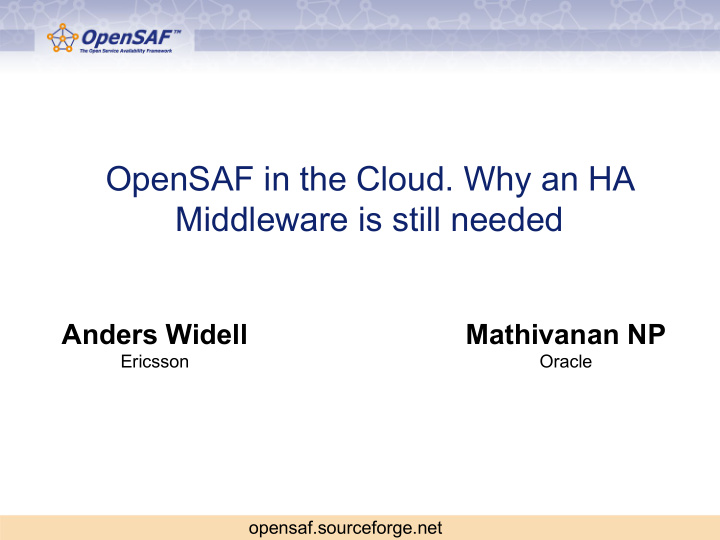



OpenSAF in the Cloud. Why an HA Middleware is still needed Anders Widell Mathivanan NP Ericsson Oracle opensaf.sourceforge.net
Agenda ● The OpenSAF Project ● High Availability and Service Availability ● Why Application HA is necessary in the cloud ● OpenSAF HA capabilities ● Proposal to leverage OpenSAF HA with existing cloud solutions for unified availability management ● OpenSAF roadmap
OpenSAF High Availability and the Cloud We have ‘The cloud 99.99% uptime. We Should we people are are good consider the here’ telcos? What is SA? What is Deployments They OpenSAF? will anyway have 5 They have have Nines APIs? standbys SAF/OpenSAF Cloud
The OpenSAF project ● Most comprehensive Service Availability middleware providing availability, manageability and platform services for developing HA available applications ● Interface APIs in C with support for Java and Python bindings ● LGPL v2.1 license ● Implements SA Forum AIS specification ● Supported by the OpenSAF foundation
High Availability and Service Availability ● The probability that a service is available to its users at a random point in time ● In telecom, 99.999% availability (five nines) is often required ● HA and SA are essentially the same, but SA enables more – for example planned updates of hardware and software
Two Opinions about Application HA in the Cloud The cloud doesn't change anything regarding HA – it is the You don't need to worry same as outside the about HA – the cloud cloud will take care of that for you
High Availability and Service Availability
Hardware Faults ● The cloud infrastructure can handle hardware faults for you – all the application sees is a node reboot ● With a hot standby VM, even a reboot may be avoided ● Problem with co-located VMs – we don't want to have active and standby app on the same physical node
Software Faults ● Applications currently have no or limited HA support from cloud infrastructure ● Using HA middleware, we can also get shorter fail-over time in the event of a hardware fault
The Cloud Gives You More Faults ● Hypervisor and cloud infrastructure are also subject to faults ● Hardware used in cloud may be less reliable (not carrier grade) ● Geographic distribution may decrease the risk of total outage, at the cost of network latency and increased risk for split-brain
The cloud way – pets vs. cattle • Pets: few powerful nodes, scale-up • Cattle: many cheap nodes, scale-out • “architecting for failure” vs “architecting for scale”
The cloud way – Standardized Service Level Agreement Your problem was triggered by some other Provide service vendor/service inside throughout the the cloud year
OpenSAF based HA ● OpenSAF based HA solutions are applicable across the availability spectrum: ● Enterprise ● Telecom and aerospace/defense ● Millisecond failover
OpenSAF based HA Supports all redundancy configurations (Including no redundancy) Orchestration Express of rolling Dependencies upgrade of the between cluster nodes. distributed/ Standardized stand alone Fault manageability software Management policies (Recovery and Repair) Monitoring Code intrusive and or Not? Healthcheck Lifecycle scripts and timeouts configuration, workload management
OpenSAF based HA - Fault Management • Detection - Component Health Checks, Active/Passive Monitoring, api based error reporting, resource agents • Isolation - Node Power off or Resource isolation • Recovery - Failover of role assignments to standby/spare resources ● Repair - Automatic restart of failed resource ● Notifications – Standardized state change notifications (and logging)
OpenSAF HA – Key Advantages ● Provide for Availability as a service in the cloud ● Centralized/Streamlined orchestration of workload management (maintaining affinity) ● Enable cloud software to be more carrier grade ● Ease of Integration – With Both API based and scripts based entities (software, vm, agents, etc)
OpenSAF HA – Key Advantages ● Enables reliability for stateful applications ● Application level failure detection and recovery. Enables fault mitigation and milli second failover ● Support for automated rolling upgrades across the cluster involving application and cluster expansion/shrinking ● Pythonic interface for provisioning, status and management of HA entities. (Java mappings also supported)
Leveraging existing cloud solutions with OpenSAF
OpenSAF and Vmware (A study) OpenSAF and Vmware (A study) ● Outage time measured with/without adding OpenSAF capabilities to existing VMware solutions (FT and HA) ● Outage time measurement by running OpenSAF within and outside the VMs and other combinations ● OpenSAF can detect Hardware, OS and Application failures ● The study concluded that outage time significantly reduced when combining OpenSAF with existing Vmware capabilities Reference: Ali Nikzad's thesis: 'OpenSAF and Vmware: From the perspective of HA' http://spectrum.library.concordia.ca/978013/4/Nikzad_MASc_S2014.pdf
Leveraging openstack and OpenSAF ● OpenSAF can provide HighAvailability as a service in openstack – Uniform, centralized, automated availability management across openstack ● Openstack's flexible deployment architectures enables easy integration with OpenSAF for all redundancy configurations for any of the OpenStack infrastructure software (distributed and standalone) ● Monitoring (Intrusive and Non-Intrusive) a basic requirement - With/Without Resource agents. ● Provide for a perspective of TRY_AGAIN /TIME_OUT semantics
OpenSAF provides for a Unified HA Integrated HA architecture for compute, network, storage, dashboard Unified view and/of Availability Management Unified Application HA HA from OpenSAF Provides for openstack VM HA 'availability architecture, hierarchy' and 'standardized management' (admin, log, notification, upgrade) interface
OpenSAF Roadmap ● Enhanced cluster management (quorum/consensus based membership) ● Scaling out even further ● Feature rich CLI ● Container - contained
& Thank You
Recommend
More recommend